The forced removal of the Cherokee tribe, also known as the “people of different speech”, is one of the most deplorable events in American history.
This event, also known as the Trail of Tears (1838-1839), occurred when gold was discovered on relocated Cherokee land in Georgia. The land in Georgia was originally granted to the Cherokee because their past land was lost as a result of the French Indian War.
Once gold was discovered in Georgia, many motions began to remove the Cherokee from all surrounding areas. Congress passed the Indian Removal Act of 1830, which was implemented by US troops.
Folks were kicked out of their homes at gunpoint and were forced to relocate to camps in large numbers. All refugees were then sent west with all of their food and belongings on their backs.
Here are the Native American foods that Cherokees ate during hard times.
Related: The Cherokee’s Favourite Edible Tree (PawPaw)
Unfortunately, the Trail of Tears is not the only mass event that shook the Cherokee nation, however, the Cherokee still needed to eat during these tough periods.
What The Cherokee Ate on the Trail of Tears
The event spanned 5,043 miles across 9 states; Arkansas, Alabama, Georgia, Illinois, Kentucky, Missouri, Oklahoma, Tennessee, and North Carolina.
During this time, it is said that the Cherokee survived on the following foods daily:
- 2 cups of hot water
- Cornbread
- One turnip per person
All people were expected to survive on these rations and also move great distances on foot. Many died from disease, starvation, exhaustion, and exposure to the gruelling elements.
Cherokee Settlement Crops
It’s safe to say that once the Cherokees’ land was in question, their entire lives were at stake. Even with the numerous forced relocations, the Cherokee always took care of the land around them. They planted several nutritious crops to keep their civilization alive.
Corn, beans, and squash were the most common crops grown by the Cherokee.
The three plants were often referred to as the “Three Sisters” because they were planted next to one another in their fields, looking like sisters of different heights and shapes. They also thrived best when grown together.
Related: The Three Sister Garden Plans: How To Get The Most Out Of Every Square Foot
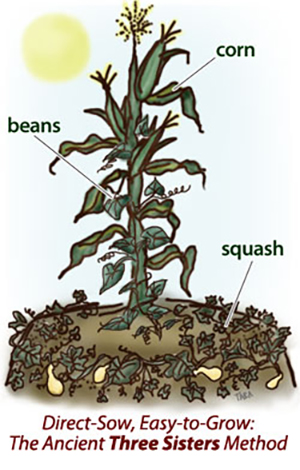
A variety of additional dishes were made out of corn by the Cherokee.
They often ground the corn and mixed it with water to create a flatbread-type dish or cornbread. They also made popcorn as a treat!
Beans made up for a lot of the fiber in the Cherokee diet. The beans most resemble modern-day pinto beans and were added to soups and stews for heft.
A very easy crop to grow, squash was eaten for almost every meal of the day.
The Cherokee would eat it in a variety of ways, often combining it with corn and beans in the same dish.
Other Common Native American Crops
These foods were also farmed and enjoyed by the Cherokee:
- Sweet potatoes
- Peanuts
- Sunflower seeds
- Pumpkins
- Melons
- Tobacco
- Apples
- Peaches
- Nuts
Cherokee Settlement Hunting
The Cherokee did not live a vegetarian lifestyle; however, they did utilize all of the animal once killed. In fact, the Cherokee thrived on eating a diet of mostly meat with the Three Sisters being incorporated into each dish.
Hunting for sport was not a part of their culture. They hunted many different animals depending on geographical location.
Coastal Cherokee were known to hunt small shellfish, fish, and turtles. Inland tribes hunted many animals including deer, elk, moose, rabbits, turkey, buffalo, fox, squirrel, and most surprisingly, bear.
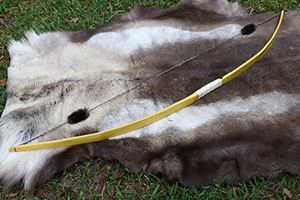
No matter the animal, all parts were used for a purpose. Meat was fed to the people, skin was used to make clothing or blankets, bones were used for cooking or building structures and furniture. Nothing was wasted, which was a way of giving back to mother nature for providing sustenance.
In addition to hunting, some Cherokee also raised animals such as turkeys for a consistent food source. After European contact, the Cherokee began housing cattle. Before European settlement, the Cherokee would keep small dogs around their land and use them for food. This practice is long-over with.
Cherokee Settlement Gathering
The Cherokee were so efficient that in addition to farming and raising animals, they were also gatherers.
The women would often go out gathering lots of wild edibles for the community to share. They never picked more than they could eat.
Many of the items foraged by the Cherokee were:
- Blackberries
- Blueberries
- Acorns
- Chestnuts
- Wild onions
- Wild garlic
- Black gum
- Hummingbird blossoms
- Cattail
- Mint
- Wild ginger
- Sumac
- Mushrooms
- Grapes
- Huckleberry
- Watercress
- Wild green beans
- Ramps
- Wild greens
All of these foods were considered super healthy and accompanied whatever meat dish was freshly hunted. Many were used in medicinal ways for treating headaches, painful menstruation, and other ailments.
Related: 10 Most Powerful Medicinal Plants Used by Cherokees
Popular Native American Dishes
Despite the times being difficult, the Cherokee always managed to make nutritious meals with whatever they had.
Here are some of the most popular Native American dishes:
Fry Bread
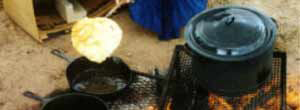 During hard times, nuts, corn, or acorns were ground into a fine flour, which was used to make this dish, which is dough fried in very hot oil until crisp and bubbly.
During hard times, nuts, corn, or acorns were ground into a fine flour, which was used to make this dish, which is dough fried in very hot oil until crisp and bubbly.
Fry Bread can still be found on Native American reserves today.
Cherokee Three Sisters Stew
 This nutritious meal would have been made from stewed beans, corn, and squash. Perhaps the fish or meat that was caught that day would make it into the stew.
This nutritious meal would have been made from stewed beans, corn, and squash. Perhaps the fish or meat that was caught that day would make it into the stew.
Pemmican
A high-protein snack made from ground meat was referred to as Pemmican.
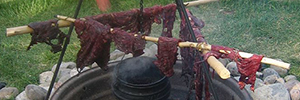
It is a mixture of tallow, ground bison or deer, and ground berries. You can still find this dish in some parts of the country.
Succotash
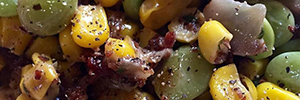 This dish consisting of lima and other shell beans, corn, or squash is a fresh salad that sometimes contains meat, potatoes, tomatoes, and other leftovers from dinner the night before.
This dish consisting of lima and other shell beans, corn, or squash is a fresh salad that sometimes contains meat, potatoes, tomatoes, and other leftovers from dinner the night before.
Wild Rice and Cranberry Pancakes
Wild rice can be found in many Native American dishes.

Dating back generations, wild rice and dried cranberries make up this filling salad along with celery, carrots, or potatoes.
Acorn Bread
Ground acorns make for excellent flour. Acorn bread is made from finely ground foraged acorns.
Catfish
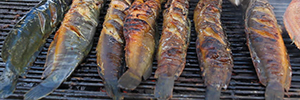 Especially in coastal places, catfish and other seafood were very commonly eaten in Native American communities. Catfish would often be eaten with foraged fiddlehead ferns, which are considered a delicacy today.
Especially in coastal places, catfish and other seafood were very commonly eaten in Native American communities. Catfish would often be eaten with foraged fiddlehead ferns, which are considered a delicacy today.
Buffalo Ribs
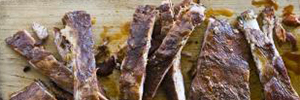
For Cherokee communities more inland, buffalo were a common hunted meal.
The large buffalo ribs are a treasured dish when cooked low and slow until the meat is fall-off-the-bone tender.
Prickly Pear Cactus Jelly

Another commonly foraged food were prickly pears, and many Cherokee made jelly out of their fruits.
Prickly pear jelly is still commonly made and sold in places such as Arizona with large Native American populations.
Roast Turkey
Many traditional Thanksgiving foods are commonly consumed by Native American tribes, including roasted turkey. Also found on Cherokee tables are cranberries, potatoes, and sauteed vegetables.
All in all, it is hard to find a time in history where the Cherokee people were not oppressed.
Their land and crops were stripped from them only to relocate to an unfamiliar place thousands of miles away. In the times that they could farm, hunt, and gather, the Cherokee had a diverse diet of meats, corn, squash, beans, and other foods.
We can learn a lot from our past, and the perseverance and inspiration of the Cherokee people outweighs the brute force that wronged them.
You may also like:
 Survival Uses For Animal Bones You Normally Throw Away
Survival Uses For Animal Bones You Normally Throw Away
When Grocery Stores Go Empty – A Back Door Shopping Strategy (Video)
How to Raise Ducks – The Perfect Survival Livestock

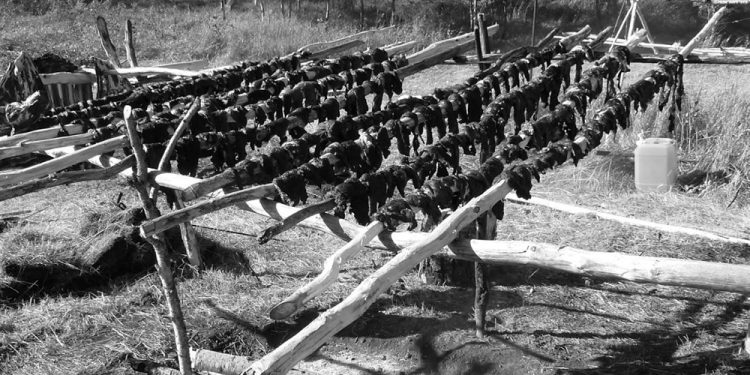




















I am impressed!! It makes us reasize how precious our food supply is and how many had to do with out until they were able grow more. They did not go to Stop And Shop!!
I have so much respect and sadness for what our Native American ancestors went through. We could learn so much more from them and the history of them if people would just wake up.
We are on the precipice of repeating these same horrendous acts, not just to our Native Americans this time but to all Americans that don’t fit into the narrative of government control.
Pay attention and pray ?
The Indian Removal Act was actually aimed at 5 Tribes, Cherokee, Choctaw, Creek, Chickasaw,and Seminole, together known as The 5 Civilized Tribes. Early in the 19th century, white Southerners, tired of fighting the Indians, offered them peace if they would adopt the Southern agricultural way of life. Fighting continued off and on, especially with the Creek and Seminole Nations, but half or more of the tribes became Southern Agriculturists, small farmers and plantation owners owning African slaves and raising cotton, corn, and tobacco. Some of the Cherokee resisted and continued traditional life in the Georgia Hills even as gold hunters moved into the area. The gold played a part in the Indian Removal Act but its primary purpose was to enable white Southerners to steal the land and slaves of the ‘Civilized’ Indians. The Trail of Tears was actually a series of forced removals between 1830 and 1836, when the Creek were finally defeated. The Seminole continued resistance and were forced into Florida and the nation of Mexico.
The other four tribes lived a combination of traditional and plantation life in Eastern Oklahoma and Texas, by the start of the Civil War owning and working four to six thousand African Slaves. Like white farms and plantations they raised a large amount of corn as the primary food for stock and people, a diet supplemented mainly by pork.
This history isn’t taught, White and Indian both are ashamed of it. It’s a lot more fun to believe the simple minded crap of the Indians being a people of super human nobility who lived in perfect harmony with mother nature. Nothing made the Indians west of The Mississippi happier than getting the horse from the Spanish because they were enabled to abandon a lot of the traditional drudgery of subsistence farming and gathering and truly live as nomadic hunters and herders.
Judge: (shh! the Cherokee think they’re the only ones 🙂
It was pretty rare any of us owned slaves a la Roma. All the gvinakii (black American Indians) are very proud to be American Indian. There’s a novel about the removal from the Choctaw point of view, Okla Hannali by RA Lafferty. Good adventure story based on fact. In it, Lafferty explains the oddness of slavery among the 5 Tribes. Only Democrats saw thing as they did on the old states.
A lot of people were moving west before the trail of tears. Many a GtT was from Indian Country. niio
The Dallas/Ft.Worth area of Texas is one of the fastest growing parts of the country, and has already outgrown the amount of water its reservoirs can supply during dry spells. There is beautiful water, and lots of it, a couple hundred miles away in Eastern Oklahoma, but the Cherokee Nation controls it. The Texans drove the Cherokee out of the State in the 1830s at gunpoint, murdering old Chief Bowles and a lot of his people. The Cherokee will never under any circumstance sell water to Texas. Ft. Worth had a case in Federal Court for years, but it declared the Cherokee sovereign in the matter. The Dawes Act stripped the Civilized Tribes of their land but they have always known how to play the game and are politically strong. If a major SHTF occurs I think the Indian Nation will once again exist in Eastern Oklahoma.
I’ll find that book by Lafferty, sounds like a good read!
Judge: That’s strange because now a lot of Cherokee live in Texas. Again. 🙂
U of OK Press has the book. https://www.oupress.com/books/9781825/okla-hannali
“Cherokee blood if not destroyed, wills win it’s courses in beings of fair complexions, who will read that their ancestors became civilized under the frowns of misfortune, & the causes of their enemies.” John Ridge
I love this article. My husband is part Cherokee and I am always looking for more information on how they lived and what they ate
There’s a store in a town near us that sells supplements and herbs. The woman who owns the store is Native American. People come from all around to have her “read” their eyes. She can tell you what is ailing you & what you need to do & take by reading your eyes.
I ask her how she learned to do this & she told me her grandmother taught her.
Some folks will probably think this is just a scam but I’ve seen her do this for both me & my wife. She read my wife’s eyes once & told her that her gall bladder wasn’t working very well. My wife told her probably not…that she didn’t even have one…it had been removed. We didn’t know her and had never met her.
I believe we as a people and a society have lost so much knowledge about the old ways and nature and the natural ways that we were intended to use & have.
Would you be willing to share where the store is located/your area town? Perhaps the information of the woman who “reads eyes”? Thank you.
Pretty good post. I just stumbled upon your blog and wanted to say that I have really enjoyed reading your blog posts. Anyway, I’ll be subscribing to your feed and I hope you post again soon.
Thank you so much!!!!! this was very helpful!! i appreciate the hard work you did to make this website ,very reliable source in my opinion!:):):):) Thanks
The forced removal of the Cherokee tribe, commonly referred to as the Trail of Tears, is indeed a tragic and deplorable event in American history. The Cherokee people, who were known as the “people of different speech” due to their unique language, were forcibly displaced from their ancestral lands in the southeastern United States.